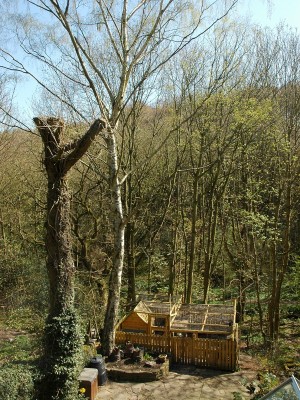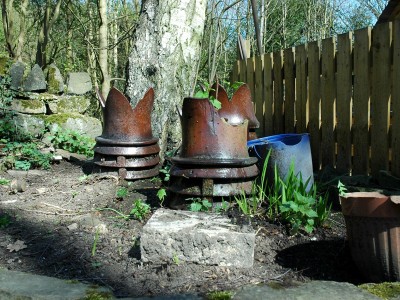Creating miniature forest gardens?
On Wednesday Linda pointed out that my sawing wood avoidance isn’t lazy but “efficient”. Yes, *cough*, efficient, I concur.
I’m trying to be as efficient as possible in the garden this year – both according to that meaning and the conventional one — and from that and some recent reading, I’m thinking of creating two small forest gardens spots in my garden.
For those not familiar with the idea, forest gardening is a way to multicrop one area – growing (usually) edible plants, shrubs and trees at up to seven different levels, from the treetop canopy levels to ground cover and even root veg. You can create them at a forest scale or even just in small container. It’s efficient in terms of space – a variety of potential food from one area – and can be efficient in the not-sawing-really-lazy sense too if most/all of the layers are perennials or self-seeders.
Both spots I’ve thinking about are in raised beds underneath trees – the first underneath a super tall 100 year old silver birch, then second under a recently planted (currently 2 years old) morello cherry. The silver birch would be canopy layer-plus-plus as it’s miles away from anything else. The cherry, which is on semi-dwarf rootstock, will grow to no more than 2.5m-3m tall so is more at the second layer, the “low tree layer”.
The idea is to have a wedge shape if at all possible – the tall things at the back, the short things at the front, so everything gets sufficient light. The trees are, usefully, in just about the right position for this – towards the back of the space (or at least with ample space to the front) and positioned so that they won’t block the sun. (The back of the house, and thus the garden, is east-facing but the southern facing aspect is completely open too so the silver birch bed gets full sun from about 10am until 4pm-5pm in the summer, and the cherry space from dawn until 2pm.)
Both spots are small and both trees will be pretty thirsty, so I probably won’t be able to plant a full set of layers of demanding fruit & veg but I think there is potential for some stuff. Even if I’m not growing huge amounts of anything in particular, as long as it’s not taking me a lot of effort, it seems to be a good use of space – especially as they’re underused/used as a dumping ground as the birch bed (at the top) is used now.
I’ve already started to plant some shrub-layer fruit bushes under the silver birch – some raspberries that’ll hopefully grow to 3ft-4ft tall. I don’t think the bed is deep enough towards the front for root veg but it’ll certainly be fine for herbaceous things — it would make sense to put borage in there (which grew to between 2-3ft last year) because it’s near the chickens who love borage and I’ve got some chard just starting off, which could go in front of that. Finally, I’m not sure I’ll have any spare plants this year but hopefully once my strawberries start multiplying, I could plant some runners as ground cover/to topple over the edge. Borage self-seeds, chard can (can’t it?) and strawberry runners will last a few years before needing swapping out – so that, in theory, sounds like it could be a lazy efficient bed.
There is only about half that space around the cherry tree so I can’t pack it out. I think big berry bushes would overwhelm the space and clash with the lower tree branches but might get away with some shorter fruit bushes – possibly a small blueberry bush (I’ve seen some that are only about 2ft tall), and when I can propagate children from my cranberry & lingonberry bushes, I could include their offspring there too (the cranberry “strands” could flop over the side of the raised bed). I guess I wouldn’t be adding either of those things this year – which would probably be good as it would let the cherry tree get established in the meantime. I wonder if there is anything not resource crazy that I could put in there now… possibly some not-moisture-crazy herbs? Rosemary? Lavender? I have some little lavender plants in the nearby herb bed which could be transplanted without too much disruption and some other rosemary plantlets nearly ready to be planted out too.
One layer I’ve not talked about is climber/vines – which is the seventh layer. If I thought kiwis or grapes would grow well enough this far up north, I’d possibly consider them for climbing up around the silver birch. Is there anything else in that category that would work? I guess I could leave some space for annual vines – “climbing” squash or something but they are very resource intensive. I’m going to make sure the beds are well enhanced with organic matter before I start but it seems silly to overload them straight afterwards.
Has anyone else created any really small scale “forest gardens”? Is there anything to watch for or need to consider? Any suggestions/advice about my initial plant choices?







Sounds like a great idea! And, if you’re staying away from labor intensive veggies for the vining part…how about a vining flower? Something that won’t take over. Not practical, but pretty, and if you can’t come up with a useful vine, why not?
I would advise testing the soil for pH levels before you plant, blueberries and cranberries need acid soil and might do better in pots. In my garden I have wild strawberries growing under a tree, the fruits are tiny but delicious.
Oh, how about a chunk of rotten log seeded with mushroom spores under the tree, if you have space and no compatible plants to plant there? Not that I know anything about mushroom propagation…And another vine suggestion-how about scarlet runner beans? Or another bean that is more of a vine type than a bushy type?
When my sister lived near Leeds, she had a kiwi in her garden, which was rampant. That was a few years ago, before the last 2 bad winters, but I think if you can get a self fertile variety, reasonably cheaply (or maybe a cutting from someone) it has to be worth a try. My only worry would be about harvesting the kiwi fruit, knowing how big they can get I have no idea how you would (safely) get to the top.
I agree with the woodland strawberries idea, but what about some heartsease pansies too? The flowers are edible, you could have the prettiest salads in Yorkshire!
Thinking of edible flowers, could you somehow train nasturtiums up the tree(s)?
Hi guys, thanks as always for your wonderful advice :)
bookstorebabe: it’s funny how I’m so obsessed with fruit & veg that I didn’t even think I could go down a flower route – didn’t even occur to me that there was some other type of thing I could grow — it was either fruit/veg or nothing ;) I think it might be too sunny for mushroom spores — but it is something I’m going to try in the more shaded parts of the garden. Beans are definitely another option for an annual veg though – thanks for me reminding me about those :)
Jan: Oh that’s very useful to know that about blueberries & cranberries — I might keep them in pots as you say, so I can manage that better. Woodland strawberries are definitely looking like an option though – I’m hearing lots of good things about them on and off line :)
Su: Semi-tropical Leeds! I’ll see if I can get a cutting from someone. I am liking the idea of edible flowers – the silver birch bed is very visible so it would be nice if it was pretty :)
Another idea I had after writing this post the other day: growing hops. They climb too and the leaves can be used as salad/a cooked green veg, as well as the (dried) flowers for stuff. They’re apparently a bit of a pain to germinate though.
Why did I noth think of a hop? Especially as I have one in my back yard.If you’re not solely thinking of food, what about an old fashioned, British native honeysuckle? Great for wildlife and of course the perfume in the evening.
I do like honeysuckles – we’ve got a big one in the front garden from my dad. I think I’ll try hops but if they don’t take, will fall back to flowers :)
I think my plan for that bed now is: silver birch at the back, then raspberry bushes and possibly a honeyberry bush, then sweet cicely (spring) and borage (summer) at the herbaceous layer, with strawberries at the front/ground and hops as a climber at the back/up the tree. Won’t really be able to get the sweet cicely or hops in until late this year/next year but it feels good to have a rough plan — and it’s a permaculture technique, not a now-a-culture one so what’s a year…? :)
I’m in the process of putting in the tree, shrub and herbaceous layer for a forest garden, but have opted to keep all vegetable beds right next to the house. They use to be 200 feet away at the bottom of the garden and I just didn’t get there very often. One of the permaculture gurus once said that if you go outside in the early morning in your slippers to get some fresh herbs for your omelette and when you get back your slippers are wet, your beds are too far away! I took that to heart and am in the middle of turning over three closest flower beds by the back door to veg beds using sheet mulching.
So far with the trees I have a standard greengage, two standard plums, two apples (one standard and one semi-dwarfing), a dwarfing pear, a mulberry and a semi-dwarfing cherry and a lemon tree. For the shrubs there’s wild blackberries at the bottom of the garden in the hedge and cultivated growing in with the wisteria over the pergola. I’ve planted a hazelnut, red, black and white currants, summer and autumn fruiting raspberries and a grape vine all together in a makeshift fruit cage to escape the finches. I’ve still to plant up in a goji berry, gooseberry, two figs and two more autumn raspberries in the cage as well. Later this month I want to buy an almond tree.
For the herbaceous level all I’ve managed so far is every new tree or shrub has its own comfrey (mulch) and mint (basil, apple or spear;insect attractor) plant plus a variety of bulbs. I also have some jerusalem artichokes to plant up here and there to slash for ground mulch. The veg beds have their own herbs stuffed in here and there, and there’s fennel which is doing it’s own thing in the flower borders year after year. I’ve got some strawberries on the go, but I’ve raised them off the ground in hanging baskets and trugs rather than on the ground where the slugs can get them. There’s rosa rugosas for the rose hips, and willow for privacy and windbreaks primarily but also for living structures, whips for weaving and a specific variety for burning on our open fire.
The garden still looks a bit bare though!
Wow, sounds like some very productive spaces! I’m sure it won’t look bare for long!
I agree with the “keep it close” philosophy for herbs and salads particularly – I’m going to try to fill our balcony with herb & salad pots this year. If I even have to put my slippers on, I’ll consider it a failure ;)